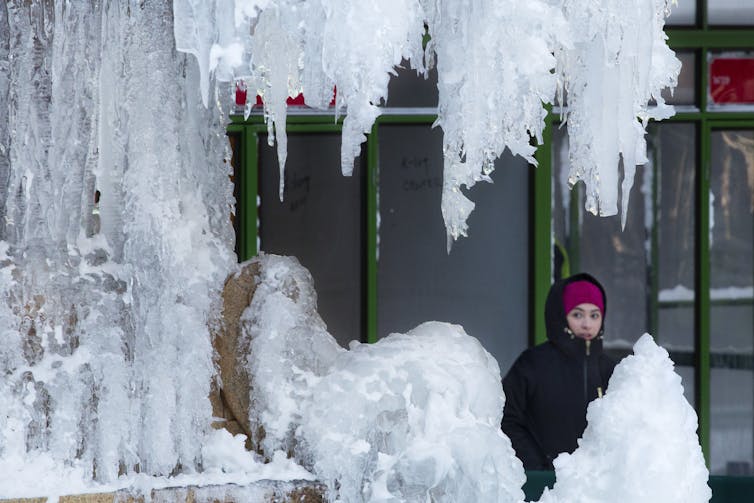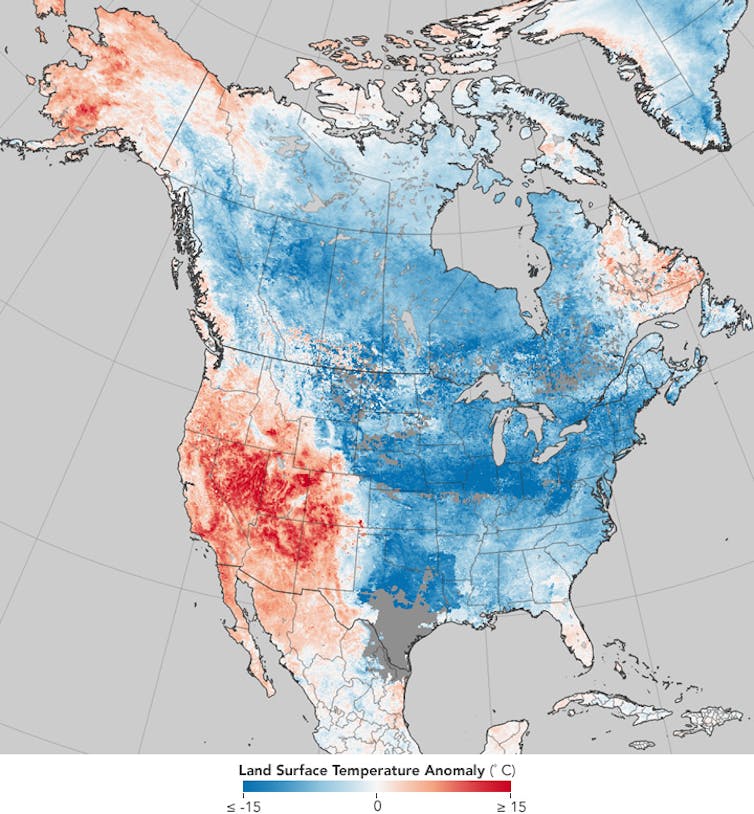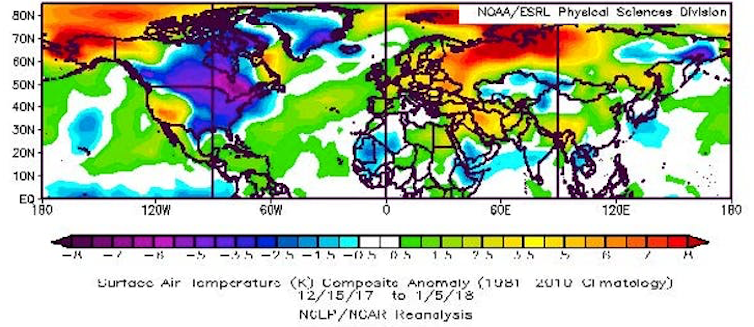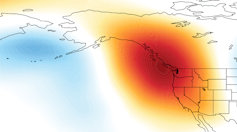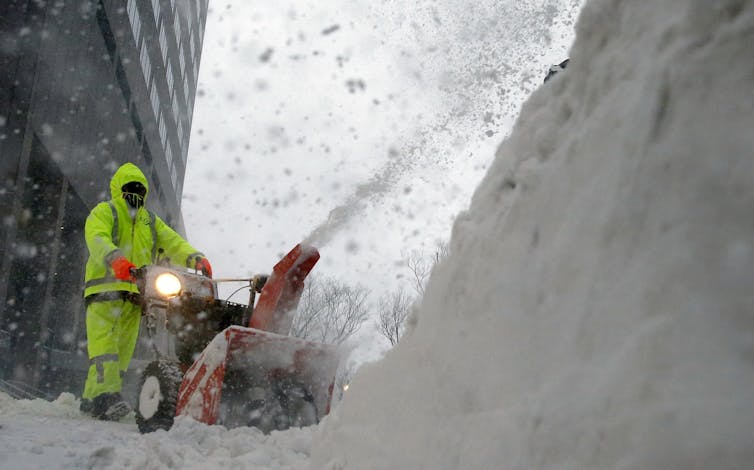The Arctic is warming up more than twice as fast as the rest of the world, due to numerous
feedbacks. At times, large areas over the Arctic Ocean can become 30°C or 54°F warmer than 1979-2000, as illustrated by the image below.
On February 27, 2018, large parts of the Arctic Ocean north of Greenland had turned into open water, as illustrated by the image below.
Yet, while the situation in the Arctic is desperate, with sea ice north of Greenland collapsing and more, mainstream media do not seem to care. If there ever were warning signs of what could eventuate, this is one. The sea ice north of Greenland is typically the thickest, as it is the least affected by melting and can build over many years. Early February 2018, sea ice north of Greenland was up to 5 m thick. To see sea ice this thick getting pushed away and open water emerging north of Greenland in the middle of winter is simply stunning.
For years, I've been warning about the situation in the Arctic, in particular the '
Open Doors Feedback', which is accelerating Arctic warming. Such feedbacks were taken into consideration in an earlier
analysis that warned about a potential 1.6°C warming globally due to albedo changes in the Arctic, in combination with associated changes such as loss of the ice buffer (latent heat), more heat transfer from the Atlantic Ocean to the Arctic Ocean due to stronger winds along the path of the Gulf Stream, and more heat entering the atmosphere or remaining in the atmosphere, due to more open water in the Arctic Ocean and as oceans get more stratified and take up less heat from the atmosphere.
So, the current situation doesn't come as a big surprise, but it's stunning to see sea ice collapse north of Greenland.
Back in March 7, 2007, I posted the article '
Ten Dangers of Global Warming', describing events getting progressively worse, with one danger feeding and reinforcing the next one, culminating in panic. Then, I thought that reading that post could at least help people better understand what's going on, and thus help people avoid panicking, but right now, I wonder whether most people do want to understand at all. Anyway, here are some images and words describing what happened over the past few days.
 |
| Jet Stream over Arctic Ocean on February 25, 2018 |
As Arctic warming keeps accelerating, there's ever less temperature difference between the North Pole and the Equator, and this slows down the speed at which the jet stream circumnavigates Earth.
 |
| Jet Stream over Arctic Ocean on February 26, 2018 |
The jet stream is getting more wavy and a more wavy jet stream makes it easier for cold air to move out of the Arctic and for warm air to move into the Arctic, so this '
Open Doors Feedback' is a self-reinforcing feedback that further accelerates warming in the Arctic.
During the northern winter, the Arctic is increasingly getting warmer than North America, Europe and Siberia. This increases the temperature difference between these continents and the oceans, which at times is causing winds to strongly speed up over the North Atlantic and the North Pacific, making an already wavy jet stream extend even further over the Arctic Ocean, reaching areas well beyond the North Pole.
 |
| Atmospheric river of heat reaches the North Pole; temperatures were as high as 1.1°C or 34.1°F on February 25, 2018 |
As the jet stream makes this detour, a huge amount of heat enters the Arctic from the south.
 |
| Temperatures above 6°C at Kap Morris Jesup, Greenland's northernmost weather station, on February 25, 2018 |
These events were preceded by the Polar Vortex splitting up. On February 9, 2018, the Polar Vortex was split up into 4 vortices and reached speeds as fast as 425 km/h or 264 mph.
 |
| Polar Vortex split up into 4 vortices |
A Sudden Stratospheric Warming event occurred on February 16, 2018, with temperatures reaching as high as 8.9°C or 47.9°F over Hudson Bay.
 |
| Polar Vortex splitting up into 4 vortices with a Sudden Stratospheric Warming event occurring on February 16, 2018 |
The heat that has accumulated in the Arctic Ocean is further illustrated by the February 2018 NASA temperature anomalies image below.
Below is an animation of sea ice thickness, from the
Naval Research Laboratory.
Arctic sea ice extent was at record low for the time of the year on February 26, 2018, at 14.159 million km². Arctic sea ice extent typically reaches its maximum in March, but maximum extent in 1991-2000 was reached on February 24. So, there is a chance that Arctic sea ice extent will go all downhill from now on this year.
Zero sea ice volume is within the margins of the trend depicted on the image above on the right. Decline of the snow and ice cover in the Arctic comes with a huge loss in albedo, which means that huge amounts of sunlight that were previously reflected back into space instead get absorbed by the Arctic. Loss of sea ice also means loss of the buffer that until now has consumed huge amounts of heat.
 |
Peak SST near Svalbard rose from
12.4°C or 55.4°F on Feb 23, 2018,
to 15.6°C or 60°F on Mar 2, 2018. |
The danger is that a sudden influx of heat can no longer be absorbed by the sea ice and will instead warm up sediments at the seafloor of the Arctic Ocean that can contain huge quantities of methane in the form of hydrates and free gas.
Destabilization of hydrates can occur in a relatively small area as a result of a relatively small temperature rise. Destabilization comes with a 160 times expansion in volume of the methane, which will send out shock waves that can destabilize nearby hydrates, causing them to destabilize as well, resulting in an eruption of huge quantities of methane over a large area.
Here's another warning sign. Peak sea surface temperature near Svalbard rose from 12.4°C or 55.4°F on February 23, 2018, to 15.6°C or 60°F on March 2, 2018, as illustrated by the red line on the image on the right, with the blue line showing the 1981-2011 average.
And here's another warning sign. High methane releases followed this chain of events on February 27, 2018, pm, likely originating from the seafloor of the East Siberian Arctic Shelf (ESAS).
 |
| Methane levels as high as 2892 ppb on February 27, 2018 |
On March 1, 2018, methane levels as high as 3087 were recorded. Note the solid magenta-colored areas over the ESAS on the image below.
The image below, with measurement by another satellite, shows that methane levels were again very high over the ESAS the next day, i.e. March 2, 2018, confirming earlier indications that this is where the very high methane releases did occur.
As the image below shows, methane levels on March 4, 2018, were still very high, i.e. as high as 2964 ppb.
The image below shows the highest mean global methane readings on March 10 over the years from 2013 through 2018, for selected altitudes corresponding to 945 mb (close to sea level) to 74 mb.
 |
| [ click on images to enlarge ] |
The table below shows the altitude equivalents in feet (ft), meter (m) and millibar (mb).
| 57,016 ft | 44,690 ft | 36,850 ft | 30,570 ft | 25,544 ft | 19,820 ft | 14,385 ft | 8,368 ft | 1,916 ft |
| 17,378 m | 13,621 m | 11,232 m | 9,318 m | 7,786 m | 6,041 m | 4,384 m | 2,551 m | 584 m |
| 74 mb | 147 mb | 218 mb | 293 mb | 367 mb | 469 mb | 586 mb | 742 mb | 945 mb |
An
earlier analysis calculated that seafloor methane could cause a warming of 1.1°C within one decade. Given a possible additional warming of 2.7°C due to just two elements (i.e. Arctic albedo changes and associated changes, and seafloor methane), a further warming of 2.1°C due to extra water vapor in the warmer atmosphere does seem well possible within a decade. Add up the impact of all warming elements of this analysis and the rise in mean global temperatures from preindustrial could be more than 10°C within one decade, as illustrated by the images below.
A rise of a few degrees Celsius would be devastating, especially when considering that the speed at which such a rise could occur leaves little or no time for plants and animals to adapt, let alone in case of a 10°C rise.
The situation is dire and calls for comprehensive and effective action, as described in the
Climate Plan.
Links• Climate Plan
https://arctic-news.blogspot.com/p/climateplan.html• Feedbacks in the Arctic
https://arctic-news.blogspot.com/p/feedbacks.html• Extinction
https://arctic-news.blogspot.com/p/extinction.html• Ten Dangers of Global Warming
https://arctic-news.blogspot.com/p/ten-dangers-of-global-warming.html• Methane Erupting From Arctic Ocean Seafloor
https://arctic-news.blogspot.com/2017/03/methane-erupting-from-arctic-ocean-seafloor.html• Warning of mass extinction of species, including humans, within one decade
https://arctic-news.blogspot.com/2017/02/warning-of-mass-extinction-of-species-including-humans-within-one-decade.html







































